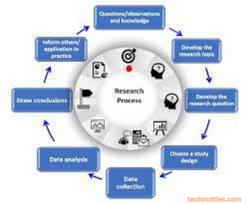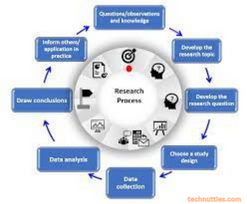Different steps involved in the research process are:-
- Identifying the research problem
- Reviewing of literature
- Choosing the study design
- Deciding on the sample design
- Setting research questions, objectives, and hypothesis
- Collecting the data from the research sample
- Process and analyze the research data
- Writing research report-developing research proposals, writing reports, disseminating and utilizing the result

Step:-1 Identifying the research problem
The first foremost task in the entire process of scientific research is to identify a research problem.
A well-identified problem will lead the researcher to accomplish all-important phase of the research process, from setting objectives to selecting the research methodology
Research needs to Identify both:-
- Non-research problem
- Research problem
a. Statement of the problem
b. justifying the problem
c. Analyzing the problem
Step:-2 Reviewing of Literature
A review of literature is an integral part of the research process. It enables the researchers to formulate their problem in terms of the specific aspects of the general area of their interest that has not been researched so far.
Step:-3 Setting research questions, objectives, and hypotheses
After discovering and defining the research problem, researchers should make a formula statement of the problem leading to research objectives.
An objective will precisely say what should be researched define the type of information that should be collected and provide a framework for the scope of the study. A well-formulated, testable research hypothesis is the best expression of research objectives.
A hypothesis is an unproven statement or proposition that can be refuted or supported by the some empirical data. Hypothetical statements assert a possible answer to the research question.
Step:- 4 Choosing the study design
The research design is the framework or blueprint for fulfilling objectives and answering research questions.
It is a master plan specifying the procedures and methods for collecting, analyzing, and processing the collected data. There are four basic research designs that a researcher can use to study;
- Survey
- Experiment
- Secondary data supply
- Observational study
The type of design to be chosen from among the above four methods depends primarily on four factors:-
- The types of problem
- The objective of the study
- The existing state of knowledge and reading about the problem that is being studied
- The resources are available for the study
Step:- 5 Deciding on the sample design
Sampling design is an important and separate step in the research process. The basic idea of sampling is it involves any procedure that uses a relatively small number of items or portions(called a sample) of a universe to conclude the whole population.
Step:- 6 Collecting the data from the research sample
Data gathering may range from sample observation to a large-scale survey in any defined data.
There are many ways to collect the data. The approach selected depends on the objectives of the study the research design and the availability of money, personnel, and time
Step:-7 Process ana analyzes the collected research data
Data processing generally begins with the coding and editing of the data. Data are edited to locate omissions if any and to ensure consistency across respondents.
Step:- 8 Writing research report-developing research proposals, writing reports, disseminating and utilizing the result
A research proposal is a work plan, prospectus, outline, offers, and a statement of intent or commitment from an individual researcher or an origination to produce a product or render a service to a potential client or sponsor.

Significance in Modern Times
“The systematics method consists of defining the problem, formulating a hypothesis, collecting the facts or data, analyzing the facts and researching certain conclusions either in the form of the solution toward the concerned problem or in the generalization for the same theoretical framework.”
- Research indicates scientific and inductive thinking and it promotes the development of logical habits of thinking and organization
- the role of research in several fields of applied economics as a whole, has greatly increased in modern times.
- Research provides the basics for nearly all government policies in our economic system
- Research has its special significance in solving various operational and planning problems of business and industry
- Research is equally important for social scientists in studying relationships and in seeking answers to various social problems
